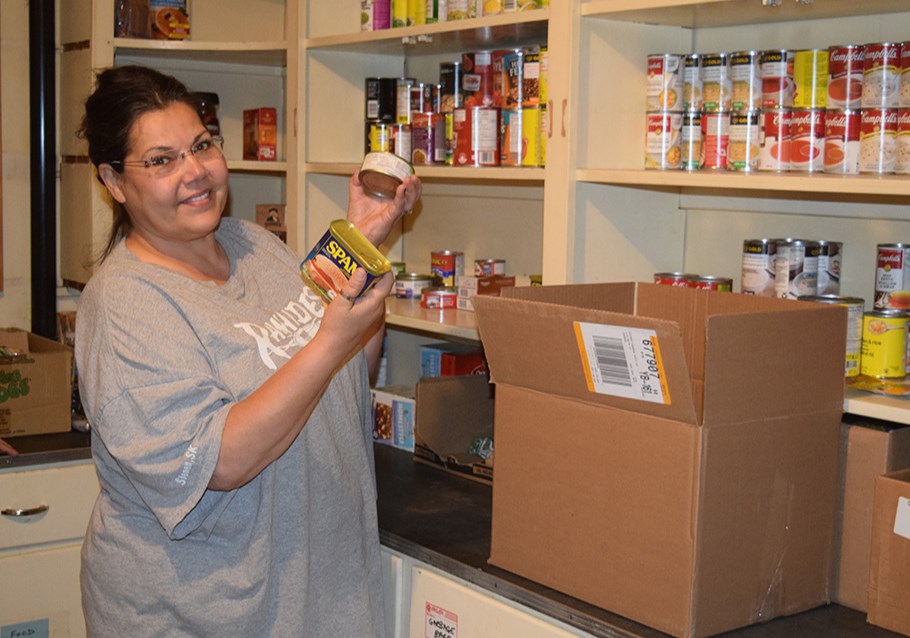CANORA - As the end of summer holidays draws near, many children are getting excited about heading back to school and hanging out with friends. But for an increasing number of families in Canora, the surrounding area, and much of Canada, there are larger issues to worry about.
Many are caught in a situation where there simply isn’t enough money to go around. By the time all the back to school supplies have been purchased, there often isn’t enough money for food, according to Pastor Mavis Watson, volunteer administrator of Filling the Gap Food Bank in Canora. Added to that, potential donors often have other things on their minds during the summer.
“I think that this time of year is particularly challenging because people are thinking about summer vacation and also winding up their summer vacation time,” said Watson. “They’re thinking about getting the kids ready to go back to school and getting back into the swing of work. Also they’re thinking about harvest on the farm, so these are some of the things that people are thinking about during this time of the year and not necessarily thinking about the food bank.”
An alarming recent trend noticed by Watson is the newcomers to the area are asking for help, “far more than ever before.
“Regular users of the food bank are still making requests,” said Watson. “It all adds up to more requests, but unfortunately donations are not up so the need is big.”
Cash donations are the most helpful, mainly for the flexibility. That allows the Food Bank to purchase exactly what is needed, rather than being restricted to only the food items that have been donated.
“We do try to stick to the Canada Food Guide in the ways that we put together the hampers,” she said.
For those who would like to donate food, Watson said they’re low on pretty much everything right now. She welcomes donations of produce fresh from the garden, especially root vegetables.
“Perishable such as tomatoes and cucumbers do not last long as well zucchinis don’t tend to be something people are looking for. But root vegetables like potatoes and carrots and onions last longer in the facility we use so we are open to those kinds of donations.”
“Also, if anyone is interested in giving meat, we can receive goods from a registered butcher if the meat has been prepared and packaged appropriately.”
Watson makes it clear that all donations are managed carefully, which includes having a certified treasurer overseeing the finances of the food bank.
“We also submit reports throughout the year to the Canora Ministerial Association so everything is looked over and looked after. It is not a one-person show.”
Presently, people are free to apply for food hampers every two months.
“Two of my greatest concerns regarding the food bank are, first, with the cost of living and inflation being so high in Canada, people are not donating the way they used to,” said Watson. “Secondly, there is whispering out there a food shortage is coming down the road for Canadians. What does this mean for those who need help from a food bank if a food bank is unable to access the goods to help them?”
The increasing strain on food bank resources is not restricted to the Canora area. According to the foodbankscanada.ca website, food bank usage in 2022 across Canada represented a 15 per cent increase from the previous year, and a 35 per cent increase compared to 2019. Stagnant provincial social assistance rates, the end of pandemic-related benefits, and soaring inflation have all affected the ability of individuals in Canada to feed themselves and their families.
According to Food Banks Canada survey respondents, the top three reasons people accessed a food bank in 2022 were: food costs, low provincial social assistance rates, and housing costs.
With the end of pandemic benefits in late 2021 occurring almost in lockstep with significant increases in the cost of living in early 2022, that timing has been particularly disastrous for low-income households. According to Statistics Canada, the lowest income segment of the population saw their disposable incomes decline by 7.5 per cent in the first quarter of 2022 compared to the previous year.
Unfortunately, the very young and the aged have been affected significantly in recent years by the financial strain. Approximately one third of food bank clients are children.
The percentage of seniors accessing food banks has increased from 6.8 per cent in 2019 to 8.9 per cent in 2022. While seniors make up a relatively small portion of the food bank population, there has been a significant increase in the number of seniors accessing food banks in recent years. This increase corresponds to the increase in the number of people whose main source of income is a pension, from 9 per cent in 2019 to 11.3 per cent in 2022.
A relatively new trend is that there has been a significant increase in the number of food bank clients who reported employment as their main source of income. The percentage of clients who reported employment as their main source of income increased from 12.5 per cent in 2021 to 14.1 per cent in 2022, concluded the information from Food Banks Canada.
At Filling the Gap Food Bank in Canora, Pastor Watson continues to be “very grateful for all the support that we receive in the community.”
Anyone who is looking to make a donation or would like more information is encouraged to phone Watson at 306-563-5315. Arrangements can be made for a pickup of a donation, or cheques can be mailed to: Filling the Gap Food Bank Canora, PO Box 957, Canora, Sk. S0A 0L0.
Don't count on social media to deliver your local news to you. Keep your news a touch away by bookmarking Canora Courier's homepage at this link.
Here's why you should bookmark your favourites.
Bookmark SASKTODAY.ca, Saskatchewan's home page, at this link.




